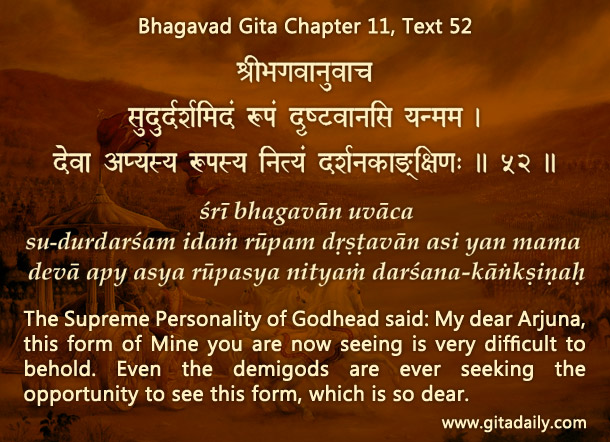Many people conceive God’s greatness in terms of size and imagine him to be a giant being pervading the whole universe. Gita wisdom accommodates such seekers by its delineation of the awe-inspiring universal form. This stunning theophany pervades the entire visual range of Arjuna who can find no beginning, middle or end to the panoply of arms, bellies, mouths and eyes (11.16).
The Gita’s championing of God’s personable manifestation underscores the primacy of intimacy in the transcendental arena.
Yet the Gita conveys its disapproval of obsession with immensity through Arjuna’s reaction: the universal form doesn’t appeal much to him. Despite being repeatedly reminded about the rarity of the vision, Arjuna desires to see it no more. Instead he desires to see again the two-handed form of Krishna – a form that the Gita declares to be rarely perceivable even for the gods (11.52).
The Gita (09.15) places those who worship the universal form in the middle between those who decry the personal absolute (09.11–12) and those who adore him (09.13–14). If the propensity for immensity of such seekers spurs them to see beyond sensual pleasures to awe-inspiring contemplation on God’s universal form, then it serves as a stepping-stone on their spiritual journey. But if that propensity makes them minimize the personal absolute due to his seemingly unimpressive size, then it becomes a stumbling block.
The Gita’s championing of God’s personable manifestation underscores the primacy of intimacy in the transcendental arena. Though Krishna can manifest awesome forms at will and though he accommodates those who desire such sights, he and his devotees delight not in displays of majesty but in plays of intimacy. One such play unfolds on the battlefield of Kurukshetra where the original creator becomes the personal charioteer of his dear warrior.
Such intimacy alone can satisfy our innermost longings for love. It is the Gita’s most confidential revelation and life’s ultimate achievement.
Explanation of article:


Leave A Comment